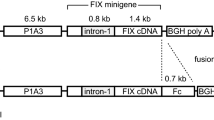Abstract
We set out to express an exogenous gene in the mammary epithelium of transgenic mice in the hope that the encoded protein would be secreted into milk. The promoter and upstream regulatory sequences from the murine whey acid protein (WAP) gene were fused to cDNA encoding human tissue plasminogen activator (t–PA) with its endogenous secretion signal sequence. This hybrid gene was injected into mouse embryos, resultant transgenic mice were mated, and milk obtained from lactating females was shown to contain biologically active t–PA. This result establishes the feasibility of secretion into the milk of transgenic animals for production of biologically active heterologous proteins, and may provide a powerful method to produce such proteins on a large scale.
Similar content being viewed by others
References
Gordon, K. and Ruddle, F.H. 1986. Gene transfer into mouse embryos. In: Development Biology. Gwatkin, R. B. L. (ed.) Plenum Publishing Corp., New York. 4: 1–36.
Palmiter, R.D. and Brinster, R.L. 1986. Germ-line transformation of mice. Ann. Rev. Genet. 20: 465–499.
Hennighausen, L.G. and Sippel, A.E. 1982. Characterization and cloning of the mRNAs specific for the lactating mouse mammary gland. Eur. J. Biochem. 125: 131–141.
Hobbs, A.A., Richards, D.A., Kessler, D.J., and Rosen, J.M. 1982. Complex hormonal regulation of rat casein gene expression. J. Biol. Chem. 257: 3598–3605.
Richards, D.A., Rodgers, J.R., Supowit, S.C., and Rosen, J.M. 1981. Construction and preliminary characterization of the rat casein and lactalbumin cDNA clones. J. Biol. Chem. 256: 526–532.
Hennighausen, L.G., Sippel, A.E., Hobbs, A.A., and Rosen, J.M. 1982. Comparative sequence analysis of mRNAs coding for mouse and rat whey acid protein. Nucleic Acids Res. 10: 3732–3744.
Lubon, H. and Hennighausen, L. 1987. Nuclear proteins from lactating mammary glands bind to the promoter of a milk protein gene. Nuc. Acids Res. 15: 2103–2121.
Hennighausen, L.G. and Sippel, A.E. 1982. Mouse whey acidic protein is a mouse member of the family of four “disulfide core” proteins. Nucleic Acids Res. 10: 2677–2684.
Campbell, S.M., Rosen, J.M., Hennighausen, L., Strech-Jurk, U., and Sippel, A.E. 1984. Comparison of the whey acidic protein genes of the rat and mouse. Nucleic Acids Res. 12: 8685–8696.
Andres, A.-C., Schonenberger, C.-A., Groner, B., Hennighausen, L., LeMeur, M., and Gerlinger, P. 1987. Ha-ras oncogene expression directed by a milk protein gene promoter: tissue specificity, hormonal regulation, and tumor induction in transgenic mice. Proc. Natl. Acad. Sci. USA 84: 1299–1303.
Reddy, V.B., Garramone, A.J., Sasak, H., Wei, C.-M., Watkins, P., Galli, J., and Hsuing, N. 1987. Expression of human uterine tissue-type plasminogen activator in mouse cells using BPV vectors. DNA, in press.
Craig, R.K., Perera, P.A.J., Mellor, A., and Smith, A. 1979. Initiation and processing in vitro of the primary translation products of guineapig caseins. Biochem. J. 184: 261–267.
Ossowski, L., Biegel, D., and Reich, E. 1979. Mammary plasminogen activator: correlation with involution, hormonal modulation and comparison between normal and neoplastic tissue. Cell 16: 929–940.
Busby, S.J., Bailey, M.C., Mulvihill, E.R., Joseph, M.L., and Kumar, A.A. 1986. Expression of human tissue plasminogen activator in transgenic mice. American Heart Assn. 74: II–247a.
Choo, K.H., Raphael, K., McAdam, W., and Peterson, M.G. 1987. Expression of active human blood clotting factor IX in transgenic mice: use of cDNA with complete mRNA sequence. Nuc. Acids Res. 15: 871–884.
Hammer, R.E., Pursel, V.G., Rexroad, C.E., Wall, R.J., Bolt, D.J., Ebert, K.M., Palmiter, R.D., and Brinster, R.L. 1985. Production of transgenic rabbits, sheep and pigs by microinjection. Nature 315: 680–683.
Yang, R.C.-A., Lis, J., and Wu, R. 1979. Elution of DNA from agarose gels after electrophoresis. Meth. in Enz. 68: 176–182.
Overbeek, P.A., Chepelinsky, A.B., Khillan, J.S., Piatiagorsky, J., and Westphal, H. 1985. Lens-specific expression and developmental regulation of the bacterial chloramphenicol acetyltransferase gene driven by the murine α-A crystallin promoter in transgenic mice. Proc. Natl. Acad. Sci. USA 82: 7815–7819.
Hsiung, M., Fitts, R., Wilson, S., Milne, A., and Hamer, D. 1984. Efficient production of hepatitis B surface antigen using a bovine papilloma virus-metallothionein vector. Jour. Mol. and Appl. Genet. 2: 497–506.
Granelli-Piperno, A. and Reich, E.J. 1978. A study of proteases and protease inhibitor complexes in biological fluids. J. Exp. Med. 148: 223–234.
Author information
Authors and Affiliations
Rights and permissions
About this article
Cite this article
Gordon, K., Lee, E., Vitale, J. et al. Production of Human Tissue Plasminogen Activator in Transgenic Mouse Milk. Nat Biotechnol 5, 1183–1187 (1987). https://doi.org/10.1038/nbt1187-1183
Received:
Accepted:
Issue Date:
DOI: https://doi.org/10.1038/nbt1187-1183
- Springer Nature America, Inc.
This article is cited by
-
Generation of goats by nuclear transfer: a retrospective analysis of a commercial operation (1998–2010)
Transgenic Research (2020)
-
Expression of human lysozyme mRNA in the mammary gland of transgenic mice
Transgenic Research (1994)




